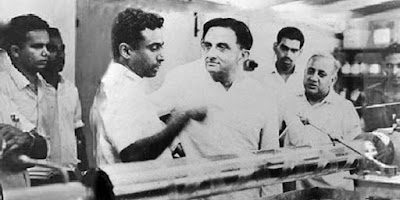(This month, each day, except the four Sundays, I will be blogging about interesting features associated with Bengaluru, formerly known as Bangalore, as part of the Blogging from A to Z April Challenge)
Indian Space Research Organisation is another premier national institution that is headquartered in Bengaluru.From 1962 when ISRO was set up by the Indian government at the prodding of an internationally renowned physicist and astronomer Vikram Sarabhai ... to 1975 when India built its first satellite called Aryabhatta ... to recent years like 2019 when Chandrayaan 2, India's second lunar exploration mission, was launched ... it has been a long way.
 |
| Two leading space scientists, Vikram Sarabhai (right) and Abdul Kalam (left), giving shape to India's space programme. Kalam also served as India's President. Photo source: ISRO |
CHANDRAYAAN 2
In September 2019, Chandrayaan 2 famously missed its mark by a whisker when the lander, Vikram, carrying the rover, Pragyan -- which was supposed to land on the near side of the moon -- deviated from the intended trajectory. (I blogged about this.)
A successful landing would have made India the fourth country after the erstwhile Soviet Union, the US and China, to do so. ISRO is not giving up -- it's planning another attempt with Chandrayaan 3 some time this year, or next year.
EDUCATION, COMMUNICATION
One of the early projects was the SITE or Satellite Instructional Television Experiment, designed jointly by ISRO and NASA, in 1975. It brought educational programmes to rural India.
A good junk of India's satellites are those related to communication -- a series called Indian National Satellite System, comprising a number of geostationary satellites, started in 1983. There are close to 30 of them.
According to the ISRO, it has so far launched 111 spacecraft and done 82 launches from Satish Dhawan Space Centre SHAR, Sriharikota, a small island in the Bay of Bengal off the coast of Andhra Pradesh.
It includes as many as 342 foreign satellites of 34 nations.
 |
| Photo source: ISRO |
The latest was as recent as February 28 this year, when the Polar Satellite Launch Vehicle PSLV-C51 sent up into orbit Amazonia-1, the optical earth observation satellite of the National Institute for Space Research, along with 18 co-passenger satellites.
CONTROVERSIES
Space exploration is also very controversial since it involves mind-boggling sums of money.
Some say even a small percentage of money that is spent on space missions is more than enough to improve our lives on earth.
But the other side of it -- a positive one -- is that a lot of our modern-day comforts, conveniences and solutions to many problems have some connection with what we have learnt from our space ventures. That can be another post on some other occasion.
(Tomorrow, the last day of the 2nd week of AtoZing, we look at something foreign in Bengaluru)
